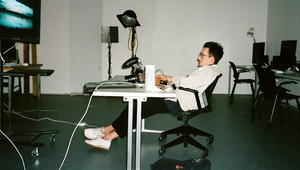
5 Minutes with… Noam Murro

Biscuit Filmworks’ Noam Murro has directed singing dogs, hordes of battle-hardened Spartans, storm-lashed ships, intergalactic super soldiers, bootylicious businessmen and discomfiting young precogs with a taste for milk… but his current project might be the most exciting yet. He’s directing an all-star adaptation of the Richard Adams novel Watership Down, a £20 million CG animated co-produced miniseries from the BBC and Netflix. Though ostensibly about a colony of rabbits searching for a new home, it’s a tale of endurance, exodus and the deceptive brutality of the English countryside.
It’s not the first time Noam’s directing career has burrowed into the world of CG bunnies, though the award-winning Comcast Rabbit is somewhat less visceral and brutal than Hazel, Fiver and Bigwig’s fight for survival.
Throughout his career, the DGA-winning director has transcended genre and managed to avoid the kind of lazy pigeonholing that plagues many a commercials director. From full throttle VFX action and epic adventures to wry comedy and quirky performance-led pieces, his back catalogue has it all. But if there’s one thread that binds his work together, it’s emotion.
LBB’s Laura Swinton caught up with Noam to pick his brains.
LBB> You’re working on a new interpretation of Watership Down. How did you get involved in the project?
NM> Seven years ago, my dear friend, Gary, asked me if I had ever read the book as a child. When I told him I had not, he handed me a copy and said, “You should remake this.” I read the book and fell in love. The rest is being tenacious, committed, and patient. In other words, blood, sweat, and tears.
LBB> And what is about the tale of Fiver, Hazel and the rest that really got your directorial instincts twitching?
NM> It’s a story of migration that’s as relevant in 2016 as it would have been in 1917 or 1933…or was in 1972, when it was first published. At first glance, it’s a story for children, but if you look closer, you will find a story that doesn’t sugar coat life the way so many children’s books do, but remembers and respects the fact that children are simply little adults. And how many great books are there out there like that? Read it. You will never be the same. It’s not about rabbits. Trust me.
LBB> I’m sure there’s not too much you can share at the moment, but I understand from reports online that the miniseries will use CG animation to bring the rabbits to life. What sort of aesthetic do you have in mind and what do you think this realism will bring to the story?
NM> Somewhere in between the magic of Pixar, the wonder of Miyazaki, and the animation of the 1970s and early Disney, there’s a wonderful, wide-open field to play in. That’s where I wanted to meet the yarn Richard Adams spun for his kids on long car rides – that wild, liminal space between everyday life and hyper-realism…between reality and the dream of a diorama in the English countryside.
LBB> In the interview you did for the DGA site, you mentioned that you grew up in quite a musical household. Is music still a big part of your life? Do you play any instruments? And how involved do you like to get in the music supervision element of your commercials and movies?
NM> Musicality filled my childhood home, where four times a week, my family played chamber music. Music now fills my children’s home, my car, my life, and my films. It’s all about music. Everything is.
LBB> I’m kind of fascinated by architects-turned-directors – there are not many of you but there’s definitely a handful that I know of. I wonder if it’s the world-building thing or the telling-stories-with-space thing? Anyway, I was wondering if you think that training influences your approach to directing in any way? Or not?
NM> Well, architecture didn’t exactly pan out. I never built a house, and something inside me tells me that’s a blessing to whoever would have lived in it. If someone dislikes my work, better to let them shut off the computer or TV than to lie in bed and curse me all night long. But everything influences us. Everything teaches us. And every move, even the nonlinear ones, prepares us for what’s next.
LBB> Looking at your body of commercials, they really do transcend style and genre. I know a lot of directors worry about getting pigeonholed – what’s the key to avoiding that?
NM> Fear. Deep fear. Fear of everything. Fear of being bored. And fear of being unemployed. That last one goes a long way, my friends.
LBB> Your MoneySupermarket ads with Mother have been a real hit with the British public and the most recent ‘Dance Off’ was really picked up by the papers and on social media. Given the industry’s obsession with awards, how does getting that sort of massive public recognition compare?
NM> Now whenever I’m in London, paparazzi wait outside my hotel and long lenses are everywhere I turn. People stop me in the street. They want my autograph. God bless the wonderful lot at Mother London. God save the Queen. Giuseppe Verdi said it better than I ever could, “The box office is the proper thermometer of success.”
LBB> One thing I enjoy about your commercials is that you always seem right at home in CG- or VFX-heavy jobs but never let the effects swamp the humanity or the story – even in something really cartoonish like Comcast Rabbit or Halo. How do you hit that balance between pushing technology to the limits of imagination while making sure that the final film retains some semblance of a human truth?
NM> Technology schmechnology. Like anything else, VFX are just tools in service of something - a story, a character, a heart. Keep your eye on the ball: Emotion. Emotion. Emotion. It’s just that simple.
LBB> Bit of an odd one to zero in on, but the VW Confidence is one that I’ve always enjoyed ever since it came out… I know it’s not the biggest in your back catalogue but it always makes me smile. Tell me, as a director, is there any truth in the old adage about never working with animals and children?
NM> ‘Never shoot on water.’ ‘Never work with VFX.’ ‘Never work with animals.’ ‘Never work with children.’ ‘Come to that, never work with people!’ I think they are on to something…
LBB> I’d imagine shooting something as huge as ‘300: Rise of an Empire’ must have been a whole other level of scale/ambition/plate spinning! What were the main lessons that you took away from it and do you think the experience has changed the way you approach commercials now?
NM> A bigger canvas means bigger brushes, but whether you’re painting an oversized wall triptych or a thumb sketch, the work is the work is the work. Regardless of scale, every piece comes down to the same basic elements – a great idea crafted with care and as much heart as you can possibly muster.
LBB> What advice would you give to aspiring commercials directors?
NM> Advice from me? Jesus. If I must, I would say… It’s a marathon, not a sprint. Never look to the side. Keep your eyes trained on the horizon. Follow your own inspiration, no one else’s. As your perspective broadens, your skill set will naturally expand. Where it takes you may surprise you, and it will certainly humble you. Let it. Stay hungry. Use fear as fuel. And just keep running until the Zimmer frame.
LBB> Is there any kind of ad/film/genre that you haven’t worked on that you’d like to?
NM> This may sound funny, even obnoxious, but I swear I feel like I haven’t even gotten started yet.
Honest to God.













